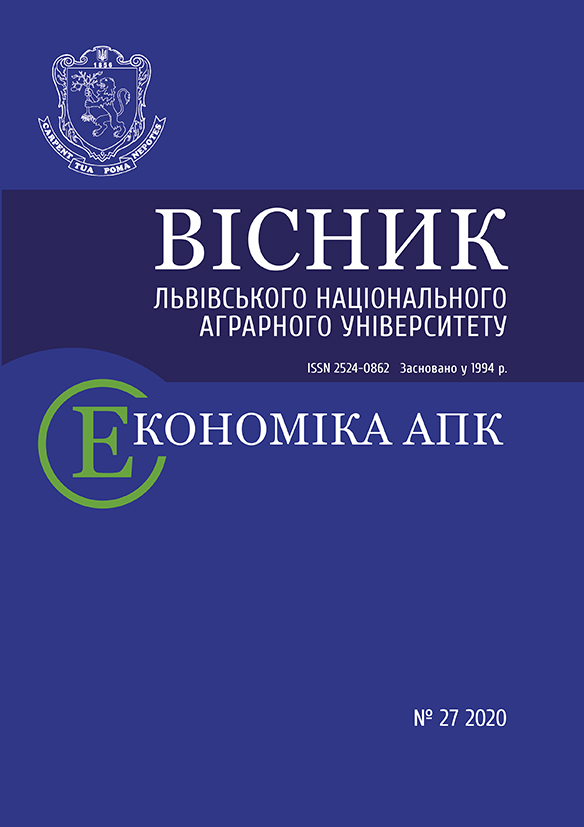Visnyk LNAU: Agronomy 2021 №25: 162-166
INFLUENCE OF MACRO- AND MICRO-FERTILIZERS ON MAIZE YIELD
Shynkaruk L., PhD student
ORCID ID: 0000-0001-5635-1924
Institute of Agriculture of Carpathian Region National Academy of Agrarian Sciences
https://doi.org/10.31734/agronomy2021.01.162
Annotation
The field study was conducted during 2018-2020 on the research field of the Research and Production Center «Podillia» of Podolsk State Agrarian and Technical University. In the studies, a hybrid of LG 3258 (FAO 250) was used
The scheme of the experiment included studying the effectiveness of foliar fertilization in combination with urea 5 % and magnesium sulfate 5 % in the following phases of maize vegetation: 10 leaves, ejection of panicles, after flowering and grain filling on different fertilizer backgrounds: N80P40K60, N120P80K90 and N160P120K120.
According to the research results, it can be concluded that the increase in the level of mineral fertilizer and foliar fertilization has a positive effect on the weight of 1000 corn grains. The greatest influence on this indicator was made by foliar fertilization at complex application: micronutrient fertilizers + urea 5 % + magnesium sulfate 5 % in a phase after flowering. With the application of N80P40K60, the mass of 1000 seeds was 302 g, against the background of N120P80K90 – 319 g. The largest mass of 1000 grains was obtained with fertilizer N160P120K120 – 343 g, which was 36 g more than the control (without fertilization).
Fertilization of corn in the norm N80P40K60 allowed to form an average of 9.98 t/ha of corn grain. The application of foliar fertilization (micronutrient fertilizers + 5 % urea + 5 % magnesium sulfate) in the phase of 10 leaves provided an increase in yield by 0.93 t/ha, ie – 10.91 t/ha of grain. The increase in the rate of fertilizers contributed to an increase in yield by 1.23 t/ha without fertilizers (control) – 11.21 t/ha. Carrying out foliar fertilizer against this background in the phase of 10 leaves allowed obtaining 12.18 t/ha. The highest level of corn plant yield was formed for fertilizer N160P120K120 – 13.24 t/ha when applying foliar fertilizer with micronutrient fertilizers, urea 5 % and magnesium sulfate 5 % in the phase of 10 leaves, which is 1.05 t/ha more than in the version without fertilization the same background of fertilizers.
Key words
corn, fertilizers, micronutrient fertilizers, foliar fertilization, yield, weight of 1000 seeds
Link
- Barlog P., Frackowiak-Pawlak K. Effect of mineral fertilization on yield of maize cultivars differing in maturity scale. Acta Scientiarum Polonorum. Agriculture. 2008. Vol. 7, No. 4. P. 5–17.
- DSTU 4138–2002. Seeds of agricultural cultures. Methods for determining quality. Kyiv: Derzhspozhyvstandart Ukrainy, 2002. 173 p.
- Hospodarenko H. M. Development and substantiation of integrated fertilization system in field crop rotation on black land podzolic Right-Bank Forest-Steppe of Ukraine: author's ref. dis. for science. doctor's degree. agr. Kyiv, 2001. 42 p.
- Hozh O. A, Marchenko T. Yu., Kotov B.S. Influence of complex microfertilizers on the main biometric parameters of maize hybrids. «Biological Research-2014»: Collection of scientific works of the V All-Ukrainian scientific-practical conference of young scientists and students. Zhytomyr : Vyd-vo ZhDU im. I. Franka. 2004. Р. 28–31.
- Kalenska S. M., Taran V. H., Danilov P. O. Features of yield formation of maize hybrids depending on fertilizer, plant density and weather conditions. Taurian Scientific Bulletin. 2018. No. 101. P. 42–49.
- Kovalenko O. A., Drobitko A. V. Influence of micro- and functional fertilizers on stress resistance and productivity of corn under climate change conditions. Climate change and agriculture. Challenges for agricultural science and education: materials of Іnternational scientific practice. сonf. Kyiv, March 13-14, 2018. Kyiv: Agroosvita, 2018. P. 727–730.
- Krestianinov E. V., Ermakova L. M., Antal T. V. Crop formation and quality of corn grain depending on the background and foliar fertilization of crops in the conditions of the left-bank Forest-Steppe. Crop and Soil Science. 2019. Vol. 10, No. 1. P. 18–26.
- Melnyk S. Methods of examination of plant varieties of cereals, cereals and legumes for suitability for distribution in Ukraine/ Ministry of Agrarian Policy and Food of Ukraine. Ukrainian Institute of Plant Variety Examination. Kyiv, 2016. 81 p.
- Moldovan J. A., Sobchuk S. I. Evaluation of individual productivity of maize plants by pre-sowing seed treatment and foliar feeding. Cereals. 2018. Vol. 2, No. 1. Р. 101–108.
- Piliarska O. O. Productivity of a hybrid of corn Cross 221M depending on conditions of moistening and density of standing of plants in the conditions of southern Steppe of Ukraine: the dissertation on obtaining sciences. degree of Cand. Agr. Science. Kherson, 2016. 165 p.
- Polishchuk M. I., Palamarchuk O. D. Influence of foliar fertilization on productivity of maize hybrids. Agriculture and forestry. 2016. No. 4. P. 102–109.
- Prystash I. V. Agrochemical assessment of the application of fertilizers for corn for grain in crop rotation on meadow-chernozem carbonate soil of the Forest-Steppe of Ukraine: dis. Cand. Agr. Sciences. Kyiv, 2005. 20 p.
- Rudavska N. M., Hlyva V. V. Formation of productivity of maize hybrids in the conditions of the Western Forest-Steppe. Foothill and mountain agriculture and animal husbandry. 2018. No. 64. P. 120–132.
- Svydyniuk I. M., Asanishvili N. M., Velychko V. P. Productivity of maize hybrids depending on technological factors in the northern forest-steppe. Agriculture. 2006. No. 78. P. 40–46.
- Tanchyk S. P., Tsentilo L. V. Peculiarities of corn fertilizer for its cultivation on typical black land in the Forest-Steppe of Ukraine. Scientific Bulletin of the National University of Life and Environmental Sciences of Ukraine. 2017. No. 269. Р. 74–83.
- Tsykov V. S., Dudka M. I., Shevchenko O. M., Nosov S. S. The effectiveness of foliar fertilization of corn with trace elements is compatible with nitrogen fertilizer. Bulletin of the Institute of Steppe Zone Agriculture of NAAS of Ukraine. 2016. No 11. P. 23–27.
- Zakharchenko E. A. The effectiveness of zinc in the cultivation of corn for grain. Bulletin of Sumy National Agrarian University. 2019. Issue 4. P. 8–14.



